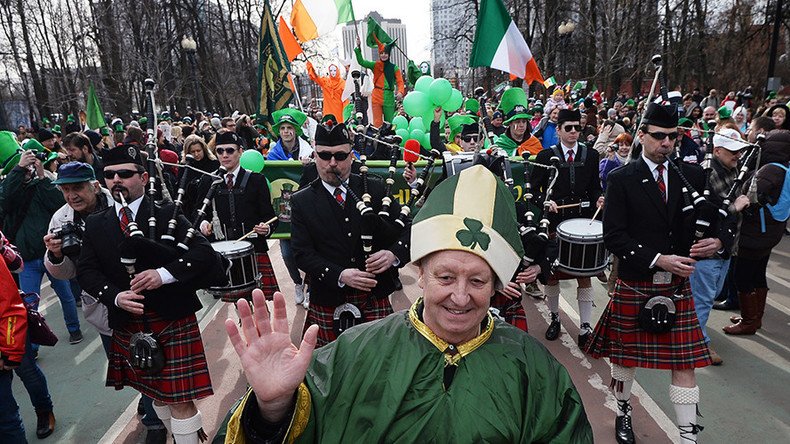Twice the craic? Russian Orthodox Church takes on celebration of St. Patrick’s Day

The Russian Orthodox Church has officially added a day to celebrate St. Patrick, Ireland’s patron saint, to its calendar. There’s a catch: the March 17 holiday, which Moscow has already been enjoying for 25 years, is set to be marked on March 30.
READ MORE: Shamrockgate: Trump’s ‘St Patty’s Day’ MAGA hat fail draws ire of the Irish
The difference is due to the Orthodox Church’s tradition of following the Julian calendar, which runs 13 days behind the Gregorian calendar. A notable example of the discrepancy between the two is Christmas, which Russians and other Orthodox Christians celebrate on January 7.
While St. Patrick was already venerated in the Orthodox tradition (and even had some icons drawn after him), he, along with several other Western saints, has now been honored with a separate day in the ecclesiastical calendar following the decision of the Holy Synod of the Russian Orthodox Church.
Blessed icon of St Patrick of #Ireland via @DanMulhall @RMontgomeryIRL pic.twitter.com/M88yJ8fFUW
— Euripides Evriviades (@eevriviades) March 30, 2014
“In total, more than a dozen of saints who had struggled in Central and Western Europe before 1054 were added to the Menologion. They include saint Patriky, the Enlightener of Ireland, better known among the faithful of our country as Saint Patrick,” Moscow Patriarchy spokesman Vladimir Legoyda told Russian media.
St. Paddy’s journey from Dublin to Moscow
St. Patrick, the fifth-century Christian missionary of Romano-British origin, became known as the Apostle of Ireland and the nation’s chief patron saint. Among his many feats, Patrick reputedly used the three-leafed shamrock to illustrate the concept of the Holy Trinity to then-pagan Celts, and also banished all snakes from Ireland – or so the legend has it.
READ MORE: Global Irish party celebrates St. Patrick’s Day (VIDEOS)
St. Patrick’s Day marks the date of the saint’s supposed death, but over the years it came to be associated with all the things Irish, with carnival-like parades accompanied by music, dance, and quite a lot of drinking becoming ingrained in the West, along with the ubiquitous green shamrock. Carried across the world by the multi-million Irish diaspora, the holiday has seen streets and entire rivers turning green from Chicago to Auckland.
Following the collapse of the Iron Curtain, many Russians embraced both the richness of traditional Irish culture, and the fun their globally-known festival offered. That and the business ties forged between Dublin and Moscow during perestroika – including Russia’s first-ever duty free shop in Sheremetyevo Airport – probably played part in Moscow officially sanctioning St. Patrick’s Day’s parade to be held in 1992.
Fast forward 25 years, and hundreds of Russians in cities like St. Petersburg, Nizhny Novgorod, Kazan, Chelyabinsk, Novosibirsk, and Khabarovsk are marking the Irish holiday with Irish music and Irish dance. Those are accompanied by pints of Guinness in Irish pubs now found all across the country from central Moscow streets to such unlikely places as desolate steppe near Siberia’s Lake Baikal. Some Russians are even learning the Irish language – only spoken nowadays by about one percent of the Irish population.
READ MORE: ‘Riverdance effect’ reaches Siberia
The official Moscow parade has moved from the iconic central Arbat Street to Sokolniki Park, but despite it still being popular with musicians, revelers and occasional overseas guests, the parade itself is now just one of the highlights of what locals call St. Patrick’s Week. This “week” spanning 10-14 days encompasses music, dance and film festival events both highly-publicized and seldom seen in the media. Some could include Irish music bands, made up entirely of Russians, playing for Irish set dances, danced by Russian couples. The above is all true for a list of Russian cities, where Irish culture is all the rage with the younger generation.
Which brings us back to the seemingly bizarre March 30 date the Orthodox Church will celebrate St. Patrick from now on. Will it stand apart, or will it actually become absorbed in the St. Patrick’s ‘Week’ celebration, making it two times the fun? Remember Christmas – Russians don’t mind celebrating twice, after all!
Check out RT’s report on St. Patrick’s Day 2016 parade in Dublin












